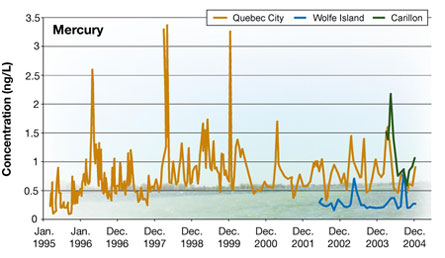|
|||||||||||||||||||||||||||||||
|
|||||||||||||||||||||||||||||||
|
ST. LAWRENCE INFO
According to analyses performed by scientists at Environment Canada, the quality of fresh water in the St. Lawrence River compares favourably to that of other watercourses. In fact, no exceedances of the quality criteria for protection of aquatic life were recorded for the various toxic substances measured at the sampling stations in Carillon, Wolfe Island or Quebec City in 2003–2004.
Trends in metal concentrations measured at Quebec City since 1995 The tributaries and the eroding banks and bed of the river are estimated to be the largest sources of metal inputs to the St. Lawrence. Some metals measured at Quebec City display a slight decreasing trend since 1995, whereas others are rising slightly. These trends can be explained by a minor decrease in the proportion of water entering the system from the Great Lakes in favour of water from the St. Lawrence tributary rivers. Mercury concentrations have increased markedly since 1995. This is due not simply to hydrological factors, but rather to an increase in anthropogenic sources that have yet to be identified. These sources could very well be located outside the St. Lawrence basin, as mercury is highly volatile and can be transported over great distances in the atmosphere.
Trends in PAH concentrations measured at Quebec City since 1995 Dissolved PAH concentrations display high seasonal variability, being highest in winter and lowest in summer. Unlike metals, these variations are not related to the water cycle; the high concentration of PAHs in winter probably testifies to the increase in the combustion of wood and other fossil fuels. Indeed, the highest PAH concentration measured since 1995 corresponds to the period following the 1998 Ice Storm. Temporal trends calculated since 1995 show a slight increase in PAHs in suspended particles, while levels in the dissolved phase are unchanged.
Trends in atrazine concentrations measured at Quebec City since 1995 While pesticide concentrations fluctuate greatly on a seasonal basis, no upward or downward trend has been observed since 1995. The Great Lakes Basin is by far the largest source of the three pesticides — atrazine, simazine and metolachlor — detected in the St. Lawrence River. Generally speaking, the concentrations measured in the river are of the same order of magnitude as those measured at Wolfe Island, at the outlet of Lake Ontario. However, at the Quebec City station, higher levels are observed in summer, seemingly due to the application of pesticides on farmlands located in the St. Lawrence Lowlands.
Ongoing research is seeking to identify and evaluate the concentrations of new substances such as surfactants, steroids, medications and hormones in the river. These substances are likely associated with endocrine-system disruption in aquatic organisms. The results of this research will contribute to improving the task of monitoring the water quality in the St. Lawrence River.
Rondeau, B. 2005. Water Quality in the Fluvial Section: Contamination by Toxic Substances. 2nd edition. Fact sheet in the “Monitoring the State of the St. Lawrence” series. Environment Canada – Quebec Region and Ministère du Développement durable, de l’Environnement et des Parcs du Québec. Rondeau, B. 2002. Water Quality in the Fluvial Section: Contamination by Toxic Substances. Fact sheet in the series “Monitoring the State of the St. Lawrence River”. Environment Canada – Quebec Region, Environmental Conservation, St. Lawrence Centre.
Presence of Pesticides in the St. Lawrence River and its Tributaries |
|||||||||||||||||||||||||||||||
|
|||||||||||||||||||||||||||||||
|
|||||||||||||||||||||||||||||||










